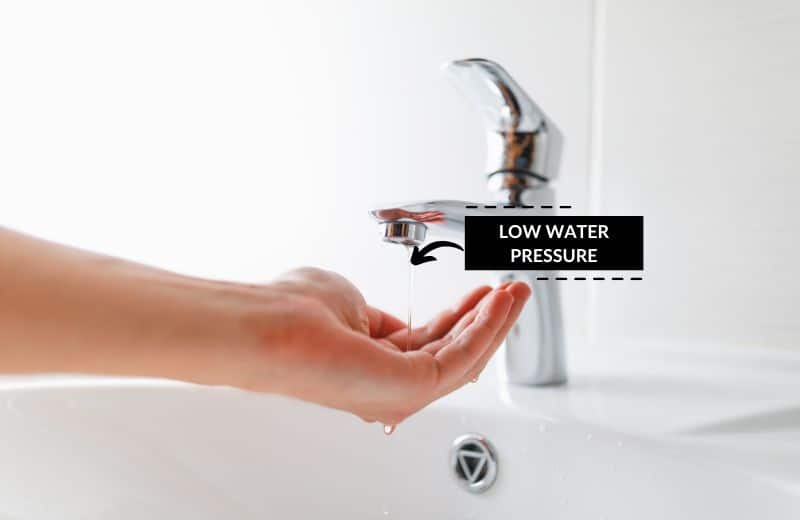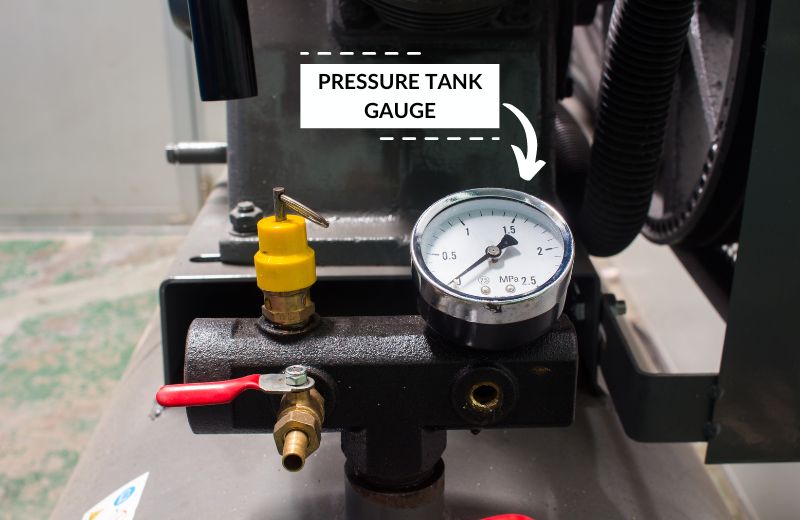A waterlogged pressure tank in your well system is a problem that needs to be addressed straight away. Without a properly operating pressure tank, your pump will run non-stop, which will eventually cause the motor to fail.
To avoid expensive damage to your other well components, be sure to troubleshoot a waterlogged pressure tank and resolve the issue as quickly as possible.
In this guide, we’ve shared the main reason for waterlogging in your well pressure tank, and how to fix the problem.
📌 Key Takeaways:
- The signs of a waterlogged pressure tank include a tank that’s full of water, repeated clicking sounds, your well water pump constantly cycling on and off, fluctuating water pressure, and a changing pressure gauge reading.
- A waterlogged pressure tank is caused by an improper ratio of water to air inside the tank.
- You can fix a waterlogged pressure tank by draining the tank, checking and adjusting the air settings, and, if a fault is detected, replacing the tank or the water bladder.
Table of Contents
🤔 How Does A Pressure Tank Become Waterlogged?
A well pressure tank becomes waterlogged when the ratio of air to water isn’t correct.
If there’s too much water in the tank and not enough air, it’s known as waterlogging. The most likely cause of waterlogging is when the rubber bladder ruptures, allowing the air and water to mix, rather than being kept separate.
Since water, unlike air, is incompressible, a waterlogged tank will cause pressure fluctuations and result in your wall pump cycling on and off repeatedly (a problem that’s called short cycling), causing the tank to intake too much water.
If a tank is waterlogged for weeks or months on end, the constant short cycling of the pump will cause the motor to eventually fail, requiring expensive repair work.

🔎 5 Signs Your Well Pressure Tank Is Waterlogged
There are a few signs to look out for that suggest your well pressure tank is waterlogged:
The Tank Is Full Of Water
A waterlogged tank contains water where it should contain air. On the other hand, a properly operating water pressure tank contains more air than water thanks to the inflated air bladder inside the tank.
If your tank is working properly, you should be able to knock on the tank and hear a hollow, empty sound. A waterlogged tank, on the other hand, won’t sound hollow because it’s full of water.
Your Water Pressure Fluctuates
A well water pressure tank is unable to properly regulate water pressure when it’s waterlogged. The pressure drops inside the tank, leading to pressure fluctuations in your home’s plumbing system.
You might notice variations in water flow when you’re running a faucet or taking a shower, and your home’s water-using appliances, including washing machines, dishwashers, and water treatment equipment, may struggle to perform efficiently.
Commonly, water pressure will start high, then suddenly drop low or die out before returning with low pressure.

Your Pressure Switch Clicks Repeatedly
It’s normal to hear the occasional clicking sound from your tank’s pressure switch as the pump cycles on and off. But if the clicking sound is very often, or every time you use water in your home, you likely have a waterlogged pressure tank.
The job of the pressure switch is to cycle the pump on and off. When the pressure tank is operating as normal, the air pressure in the tank regulates when the pressure switch should switch on and off.
But if you have a constantly running or short cycling pump, the pressure switch will constantly click on and off, giving the pump confusing instructions.
Your Well Pump Short Cycles
Following on from the above, a short-cycling well pump is also a common sign of a waterlogged tank.
This is caused by the pressure switch switching on and off more frequently than it should. In normal working conditions, the pump should only be turned on when the pressure in the tank reaches a certain low point (usually around 40 PSI).
But when the pressure tank can’t regulate water pressure, the pressure switch tells the pump to turn on too frequently. And when the pump turns on tens of times throughout the day, the motor becomes overworked and may burn out.

Unstable Pressure Gauge Reading
The final sign to look for in a waterlogged pressure water tank is an unstable or fluctuating pressure gauge reading.
A pressure gauge is a device containing a needle that gives you a reading of the pressure inside the tank. The needle should travel from the cut-in pressure (the lowest pressure that triggers the water pump to switch on) and the cut-off pressure (the highest pressure that tells the pump to shut off).
If the tank is waterlogged, the pressure inside the tank will either stay low or fluctuate, causing the needle on the gauge to give a low reading or jump around.
📖 How To Fix A Waterlogged Pressure Tank
Now we know the signs of waterlogged pressure tanks, let’s look at how to fix a water logged tank at home.
We recommend taking the following steps to resolve the issue:
Step 1: Determine The Cause
You want to be certain that waterlogging in your well tank is the cause of the pressure drops or fluctuations. Inspect your water tank and look for the common signs listed above.
To be absolutely certain, you could also call the tank’s manufacturer and explain the problems you’re facing. They might ask you to perform a few specific tasks to detect excess water inside the tank.
Step 2: Switch Off The Power & Drain The Tank
Once you’re sure that you’re dealing with a waterlogged tank, you can move on to fixing the issue.
Shut off the electricity supply to the tank, then bypass any water filtering equipment to avoid potential damage from sediment disturbance in the pipes while the tank drains.
Connect a garden hose to the drain port at the bottom of the tank and open the valve. Wait for the entire tank to drain, then disconnect the hose and shut the valve.

Step 3: Check & Adjust The Air Pressure If Possible
Next, use a tire gauge to check the air pressure inside the tank. If it’s possible to adjust the pressure, do it now.
Add air to the tank using a compressor. Continue pumping air until the required pressure is achieved (it should be at about 25-30 PSI).
You can then reactivate and flush the well pressure tank until the water is clear, then put your water treatment equipment back in service.
Step 4: Replace The Tank
If you can’t adjust the air pressure or the pressure drops or fluctuates, there’s likely an internal fault in the tank.
Hire a plumbing professional to inspect your tank and advise you on the best resolution. Some water pressure tanks have a bladder that can be replaced, rather than replacing the entire tank.
However, the issue might not be specifically caused by the bladder, or it might actually be easier and more cost-effective to replace the tank itself.
The average lifespan of pressure water tanks is 15 years, so if your tank is nearing the end, it might make more sense to just replace the whole thing.

📑 Final Word
If you think your pressure tank is waterlogged, act fast. Low water pressure could cause issues with the appliances and fixtures in your home, and the pressure fluctuations in the tank will wear out the well pump motor, potentially leading to expensive damage elsewhere in your well water system.
If in doubt, call a plumber who has experience working with well systems. They can help to troubleshoot your pressure tank issues and advise you on the best and most cost-effective solutions.

